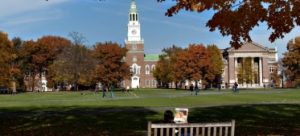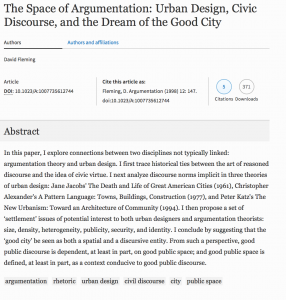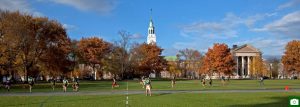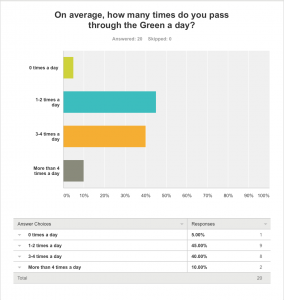Photo Exhibit:
—The Dartmouth College Green has 8 official entries to a plethora of possible pathway scenarios. These include an entry on the corner of Wentworth and Main Street, one on the corner of Wentworth and College Street, two on College Street, one on the corner of College and Wheelock Street, an entry way on the corner of Wheelock and Main Street, and two entries on Main Street. The lane designs create both small and large shapes such as triangles, squares and other quadrilaterals throughout the grass field. Although the 8 official entries create 6 official walking paths, the layout of these intersecting paths make it so that pedestrians can create their own course to follow. The complexity and freedom of these intersecting pathways makes it so that chance encounter among strangers, acquaintances, or friends are incredibly higher.
—The college’s green space is more commonly associated with being at the heart of campus, but on a smaller scale the location of this space is the direct center of four elements of or interests in life. To the north of the green, on Wentworth Street, are the southernmost buildings of Dartmouth College’s libraries. Located to the right, or to the east, of the Green are Dartmouth Hall and neighboring buildings that hold classes and lectures. To the South of the Green, The Hopkins Center for the Arts, The Hood Museum of Art and The Black Family Visual Arts Center reside. To the left, or to the west of, the Green reside food and activity centers like the Collis Student Center and the Class of 1953 Food Commons (FOCO). The Green’s centrality to these diverse places asserts the notion that in order to get to these varied places, diverse people with differing personalities and backgrounds customarily cross and interact there.
—Informal meetings exist as a result of the tranquil setting of this green space. Pedestrians rest, read, study, conversate and engage in small team games across each tiny green patch of space. Triangle and quadrilateral shapes of grass are enclosed by the perimeter of each grey, grainy walking path. These spaces offer more informal meeting as people typically pause here to break from everyday life. Students and visitors throw Frisbees around, toss the football to another, and kick soccer balls along the grooves of the grass. Some read or keep conversation on their blankets, on benches, or in groupings of friends. Benches in the green are traditional with no modern or articulated design, just simply made for comfort and interactive purpose. All benches along the perimeter of the college green face inwardly. As people break and rest in whichever position or path of green space that they choose, they can observe the community around them and learn about tendencies or commonalities of those in front of them, really digesting what it means to be a Dartmouth College community member. In a place where so many walk through and noise follows, there is a sense of tranquility that attracts people to this space
—This Green space, although officially located on the private Dartmouth College campus, draws people here from the outer Dartmouth College campus community. The space provides the perfect location for formal meetings. Typically, but not exclusively to the southern hemisphere of the college green, events are held that attract familiar and unfamiliar people to one place. Events such as farmers’ markets, musical performances, marathons, graduation and homecoming ceremonies held by private and public contributors unite sums of people each month in Hanover. The Dartmouth College Green is made up of distinctly shaped patches of grass, and of pebble, grain and dirt within each lane that familiar and unfamiliar footsteps cross each day and night. Each event allows for the chance interaction of both current and former.
—Dartmouth students, and of both Dartmouth College residents and outer community residents. These meetings that unite these different backgrounds suggests and often makes it feel as if the world is not large and that the Dartmouth community is inclusive and lasting.
Comments for Workshop:
- Claims: The layout of dartmouth’s green promotes good public discourse and increases probability of contact. The green fulfills the requirements of s “good space”. The inward facing benches and crossing gravel paths are primarily responsible for this contact. Structure: The layout of text interspersed with pictures makes for easy reading and references to the images. Evidence: The strongest evidence for your claims is the photographic evidence showing the design of the green. The most effective imagine is the aerial view of the green that shows all of the gravel pathways criss-crossing. From this it is easy to see how they promote random contact and public discourse.
Patrick O’Neill, Nov 3 at 9:48pm
- Abigail Cameron: “I really enjoyed reading the website, and I liked the linking of your piece to the claims that we spoke about in class.2. Claim about the green being a space to initiate conversation is great. I’m looking forward to seeing how the use of a poll will add to this website (and i think it will as it will only strengthen your piece)
3. I thought the structure was well utilized, as there was white space on either side, and an interspersion of words with images (which made it feel like there wasn’t too many words).
4.Evidence: I think the use of a poll or interviews, or whatever method of data collection will be beneficial in increasing the validity of the piece. Otherwise, your explanation of the green being a communal space also provides evidence for its integral part of the Dartmouth society.”
Reflection from Workshop Draft/Goals for Next Draft:
- Concerns/Question for this Project:
Can I use videos already made about the space?
How do we cite photos/videos used?
Are captions for each photo beneficial
Aligning Help
The points that I make about the Green relate to claims made in the Fleming reading, so would it be advisable to write analysis or include information about each claim from the reading after each claim that I make?
I have yet to include my interview, but I plan to include a survey students’ experiences on the Dartmouth College Green; i.e. “the frequency that they walk through the green a day” “how connected do you feel to the school/alum through events on the green?
- Claim:
The Green at Dartmouth College is a good space that initiates conversation, allows for publicity and connects the students of Dartmouth with the extended public and alumnus communities.
- Structure:
My structure closely considers balance, white spaces, and a centered alignment.
- Evidence:
My page will include more valid evidence when my interviewing process is complete, as well as when proper citation is used for my photos and videos.
- Graphic Design:
My media is located all on one page, but perhaps with home or end page my piece might be structure a little better. Various shades of green, black and white are the contrasting colors of my piece. I currently include: pictures, text, a voice tour, symbols, and a video.
- Revision Plans:
I aspire to have a more aligned and attractive draft. I plan on fixing citation to give due credit to my borrowed pieces’ owners. By adding more symbols in the next draft, I hope to make the spacing less forced, and more attractive. Once my poll is complete, I plan on creating graphs to understand the common experience on the green.
Comments from Conference Draft:
Hi Gabbie! Thanks for your work on the website. I enjoyed reading (and listening) to your account of the Green. You have a handful of compelling interpretive claims emerging, and most of those are clearly connected to your encounter with the Fleming piece. I was impressed with some of your layout decisions in this draft, and I look forward to seeing you refine this as you move into the final revision stages.
Some comments for you:
Overall Site Design:
- Re-name your site!
- Some really neat use of design features: the giant G, the triangles for section breaks; mimicking the author/date/tag system of the 99 p.i. Blog.
- Right now, the project is really one page + a supporting archive of information. A single-page site is OK, but you have other options.
- Using section titles to clarify the logical distinction between sub-claims can make your site much easier for users to navigate (page titles can work the same way if you break this up into multiple pages).
Incorporation of visual/aural content:
- You pair images with related text content. Nice job! The first image on the home page is a great example of this.
- Your audio tour was among the most polished and effective documents in the class (despite some minor issues with sound quality). In the current page, the audio tour serves the purpose of–i think–summarizing the diverse uses of the space, and aligning that diverse use with a couple of key principles: connections between users & creating a sense of community. I think you likely need to find a way to integrate those purposes with the rest of the page. The tour simply resides in the middle of the page, without any text headings or written content to help users predict what it’s about. I think you’ll need to integrate that more fully.
- Be sure to cite/caption images and include both a descriptive and source-defining element in the caption (e.g. The Green viewed from the South | photo by Gabrielle Hunter, 2016)
Purpose/Argument/Motive:
- You offer a really clear argument about the space at the top of the home page. A good place to start!
- Can you find a way to set up a clearer motive mechanism? A tension or problem/question? Is your purpose simply to expose your readers to Fleming’s model using the Green as an example?
Claims:
- Some clear claims emerging in your paragraphs;
- The design of the walkways and the landscape promotes idiosyncratic use among users, which promotes unexpected, informal encounters.
- The Green is a crossroads between buildings with different functions within the institution.
- The green promotes shared identity (via rituals like homecoming).
- Minimal benches create a kind of community publicity (sounds like Fleming).
- Events draw the Dartmouth community into dialogue with the broader Upper Valley populace.
Odds & Ends:
- You have some interesting material to work with from the interview and the survey. Rather than hosting the entire survey & interview results, I think you should mobilize those details when you are advancing claims. Marshal the evidence to support claims right when you make the claims
- You likely want to give Fleming more time/space. Your audience doesn’t know anything about him or the argument of his article.
Final Draft: PAGE 1
Good spaces initiate good public discourse on smaller and larger scales. A good public space also serves its locale. Author David Fleming asserts that “good space” and “good civic discourse” bare a dependent relationship. He perpetuates the notion that good cities and all of their respective parts initiate this discourse. Can the same notion be applied on smaller scales such as college campuses? The answer is yes. In fact, it already does. From such a perspective, The Green at Dartmouth College is a good space, in fact, it is a great space.

The Dartmouth College Green has 8 official entries to a plethora of possible pathway scenarios. Through the words of urbanologist Jane Jacobs, an interpretative lens about the benefits of walkways in public cities can help us to visualize the value of the college’s central most pathways. She asserts that, “good streets and sidewalks…are diverse and lively places which generate three social benefits” (Fleming 159). Of the three benefits that she later speaks upon, contact is the most relevant as it is commonly seen on the walkways of The Green at Dartmouth College. Although the 8 official entries create 6 official walking paths, the layout of these intersecting paths make it so that pedestrians can create their own course to follow. The complexity and freedom of these intersecting pathways makes it so that chance encounter among strangers, acquaintances, or friends are incredibly higher. Pathways intersect and create entries from each of The Green’s bordering streets. These include an entry on the corner of Wentworth and Main Street, one on the corner of Wentworth and College Street, two on College Street, one on the corner of College and Wheelock Street, an entry way on the corner of Wheelock and Main Street, and two entries on Main Street. The lane designs create both small and large shapes such as triangles, squares and other quadrilaterals throughout the grass field.
▽▽▽▽▽▽▽▽▽▽▽▽▽▽▽▽▽▽▽▽▽▽▽▽▽▽▽▽▽
THE HEART AND SOUL: THE DARTMOUTH GREEN
The college’s green space is more commonly associated with being at the heart of campus, but on a smaller scale the location of this space is the direct center of four elements of or interests in life. Fleming considers the quality of modern day cities flooded with shopping centers and “suburban sprawl”, but that seem to lack neutral, central spaces. He deems them illegitimate, claiming that, “our cities…don’t seem like ‘real’ cites at all: they’re centerless, socially fragmented, and restlessly commercial; they’re ugly, depressing and scary; they lack livability and community” (Fleming 152). A real city, by Fleming’s definition maintains a utilized central space, a soul that reflects the city’s culture. This must mean that, like a public city, on a smaller scale, a thriving college campus can be credited or discredited by its central space.

To the north of the green, on Wentworth Street, are the southernmost buildings of Dartmouth College’s libraries. Located to the right, or to the east, of the Green are Dartmouth Hall and neighboring buildings that hold classes and lectures. To the South of the Green, The Hopkins Center for the Arts, The Hood Museum of Art and TheBlack Family Visual Arts Center reside. To the left, or to the west of, the Green reside food and activity centers like the Collis Student Center and the Class of 1953 Food Commons (FOCO). The Green’s centrality to these diverse places asserts the notion that in order to get to these varied places, diverse people with differing personalities and backgrounds customarily cross and interact there.
INFORMAL BY CHANCE, FORMAL BY PLAN
Informal meetings exist as a result of the tranquil setting of this green space.
A “good public space” maintains publicity and easy accessibility. The Dartmouth Green’s open, central location makes it a welcoming space to engage upon. Drivers, bikers, and pedestrians are all exposed to this green space, giving it the publicity that any “good” public city or space requires.


Pedestrians rest, read, study, converse and engage in small team games across each tiny green patch of space. Triangular and quadrilateral shapes of grass are enclosed by the perimeter of each grey, grainy walking path. These spaces offer informal meetings as people typically pause here to break from everyday life. Students and visitors throw Frisbees around, toss the football to one another, and kick soccer balls along the grooves of the grass. Some read or keep conversation on their blankets, on benches, or in groupings of friends. Benches in the green are traditional with no modern or articulate design, just simply made for comfort and interactive purpose. All benches along the perimeter of the college green face inwardly. As people break and rest in whichever position or path of green space that they choose, they can observe the community around them and learn about tendencies or commonalities of those in front of them, really digesting what it means to be a Dartmouth College community member. In a place where so many walk through and noise follows, there is a sense of tranquility that attracts people to this space.
▽▽▽▽▽▽▽▽▽▽▽▽▽▽▽▽▽▽▽▽▽▽▽▽▽▽▽▽▽
▽▽▽▽▽▽▽▽▽▽▽▽▽▽▽▽▽▽▽▽▽▽▽▽▽▽▽▽▽
Christopher Alexander of A Pattern Language: Towns, Buildings and Construction (2007) , in Fleming’s piece, The Space of Argumentation: Urban Design, Civic Discourse, and the Dream of the Good City” , brings awareness of the importance of promenades and the role that they play in fostering intimate public gatherings in cities. Alexander suggests that, “each community have a promenade, a place where people can go to see and to be seen, to rub shoulders and to confirm their community” (Fleming 157). If this can be said about a public space such as a city, it is plausible that the same can be advertised for colleges. In this case, The Green at Dartmouth College is worthy of being considered a “good public space”, because of its ability to confirm and connect the community through events on its fields.
This Green space, although officially located on the private Dartmouth College campus, draws people here from the outer Dartmouth College campus community. The space provides the perfect location for formal meetings. Typically, but not exclusively to the southern hemisphere of the college green, events are held that attract familiar and unfamiliar people to one place. Events such as farmers’ markets, musical performances, marathons, graduation and homecoming ceremonies held by private and public contributors unite sums of people each month in Hanover. The Dartmouth College Green is made up of distinctly shaped patches of grass, of pebble, of grain and of dirt within each lane that familiar and unfamiliar footsteps cross each day and night. Each event allows for the chance interaction of both current and former Dartmouth College members, their families, their professors and greater Hanover/Lebanon area.

Both Dartmouth College students and outer community residents unite. These meetings that unite these different backgrounds suggest and often make it feel as if the world is not as large and that the Dartmouth community is inclusive and lasting.
Page 2:
DAVID FLEMING
Urban Design, All the Time: David Fleming
The man behind the movement — David Fleming.
What makes any particular domain a “good public space”? The criteria in which one may grade a space is inexhaustible. However, author David Fleming provides a conceptually rich piece in The Spaces of Argumentation as he considers the ideals of various urbanoligits, designers and authors who critique the value of public spaces and design.

The Green at Dartmouth College and its relativity to good public space can be better understood through David Fleming’s all-compassing conceptual lens. He considers the heterogeneity, publicity, identity, size, security and density of a city, but the three most striking components of his philosophy are publicity, identity, and heterogeneity.
Heterogeneity considers diversity on several scales; the diversity of the people that use this space, the diversity of the ways in which a a space can be used, as well as the diversity of the structres and building that surround then space. This diversity ensures a more integrated community.
Identity maintains the notion of “culture”, and with that so called culture, communities will find a common ground to which they can establish or commit upon. “Good public spaces” maintain identity through discourse, which is a prominent piece that encourages culture and engagement with others that share the same communal interests or goals.
Publicity associates the need for self-assessment with the responsibility of citizens. Fleming writes on the behalf of the publicity concept that, “a strong public life requires common space that is somewhere in between intimacy and isolation, between familial warmth, on the hand, and absolute segregation on the other” (Fleming 161). This aspect of a “good public space” appreciates the social assessment that events, communal stops, visible seating, etc. provide for citizens or users of the public spaces.
Before David Fleming became a spokesperson for design, discourse and city planning, he was first a teacher. At New Mexico State University, Fleming was a professor in the Department of English. A college campus is more or less a smaller scale version of a city. There, I’m sure is where he witnessed the most civic discourse, analyzed public design, dreamt of quality spaces, and then was able to foster ideals about good and bad public space.
Page 3:
THE GREEN IMPACT
WHAT THE GREEN USERS HAVE TO SAY ABOUT THIS SPACE
I gathered a small representational group of about 20 freshmen Dartmouth students and asked them about their frequency in passing through or going to the Green. Here’s what they had to say:
****More than 95% of students walk through Green each day!!
▽▽▽▽▽▽▽▽▽▽▽▽▽▽▽▽▽▽▽▽▽▽▽▽▽▽▽▽▽
An INTERVIEW with Dartmouth Student, Julianna Thompson
“the Green [is] a space that the whole Dartmouth
community could gather and use”
What was your first impression of the Green at Dartmouth College? “My first impression of the Green was when I was being recruited to play basketball at Dartmouth. The coaching staff pointed out how the Green was a space that the whole Dartmouth community could gather and use. Ever since I first visited Dartmouth, the Green stood out to me as a really unique part of the campus”
How has your view of the Green changed for the better or for the worse, since you’ve been here? “I always had a positive view of the Green, but since I’ve gotten to Dartmouth I definitely see changing for the better. The Farmers Market, Chad Hero and other events are all positive events that happen on the Green”
Do you think that events on the Green play an intricate role in encouraging interaction or conversation? If yes, how so? If not, why not? “For sure! The Green is a place for students and the greater Dartmouth community to walk, study and just hang-out. Because we live in such a secluded area, the Green offers a convenient social space for all classes. Whether you are walking across the Green to go to the dining hall or catching up with a group of friends, the Green is a place that encourages interaction and conversation.”
Does the Green ignite any sense of community or belonging in you, as a Dartmouth Student? “The Green ignites a sense of community and belonging because it is a place that is accessible to all people. Also, because the Green is conveniently located in the heart of campus, it is the centre of Dartmouth – physically and socially”
How does the design or location of the Green make it a more or less social space? “Because the Green has multiple pathways that intersect and run to different places on campus, you often pass other students and faculty. The social interactions of seeing people you know, or even meeting new people, are encouraged by the pathways on the Green”

